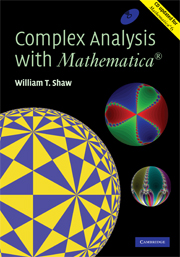Book contents
- Frontmatter
- Contents
- Preface
- 1 Why you need complex numbers
- 2 Complex algebra and geometry
- 3 Cubics, quartics and visualization of complex roots
- 4 Newton—Raphson iteration and complex fractals
- 5 A complex view of the real logistic map
- 6 The Mandelbrot set
- 7 Symmetric chaos in the complex plane
- 8 Complex functions
- 9 Sequences, series and power series
- 10 Complex differentiation
- 11 Paths and complex integration
- 12 Cauchy's theorem
- 13 Cauchy's integral formula and its remarkable consequences
- 14 Laurent series, zeroes, singularities and residues
- 15 Residue calculus: integration, summation and the argument principle
- 16 Conformal mapping I: simple mappings and Möbius transforms
- 17 Fourier transforms
- 18 Laplace transforms
- 19 Elementary applications to two-dimensional physics
- 20 Numerical transform techniques
- 21 Conformal mapping II: the Schwarz—Christoffel mapping
- 22 Tiling the Euclidean and hyperbolic planes
- 23 Physics in three and four dimensions I
- 24 Physics in three and four dimensions II
- Bibliograpy
- Index
20 - Numerical transform techniques
Published online by Cambridge University Press: 05 August 2014
- Frontmatter
- Contents
- Preface
- 1 Why you need complex numbers
- 2 Complex algebra and geometry
- 3 Cubics, quartics and visualization of complex roots
- 4 Newton—Raphson iteration and complex fractals
- 5 A complex view of the real logistic map
- 6 The Mandelbrot set
- 7 Symmetric chaos in the complex plane
- 8 Complex functions
- 9 Sequences, series and power series
- 10 Complex differentiation
- 11 Paths and complex integration
- 12 Cauchy's theorem
- 13 Cauchy's integral formula and its remarkable consequences
- 14 Laurent series, zeroes, singularities and residues
- 15 Residue calculus: integration, summation and the argument principle
- 16 Conformal mapping I: simple mappings and Möbius transforms
- 17 Fourier transforms
- 18 Laplace transforms
- 19 Elementary applications to two-dimensional physics
- 20 Numerical transform techniques
- 21 Conformal mapping II: the Schwarz—Christoffel mapping
- 22 Tiling the Euclidean and hyperbolic planes
- 23 Physics in three and four dimensions I
- 24 Physics in three and four dimensions II
- Bibliograpy
- Index
Summary
Introduction
In real-world applications if is often the case that a purely analytical approach to transform calculus is insufficient. This chapter explores two techniques that extend the utility of transform methods by allowing a purely numerical treatment. We can explore numerical methods for both Fourier and Laplace transforms – in principle any method could be applied to either type of transform, since one is a rotation of the other. However, in practice, two types of problem appear to be of most importance:
(1) An essentially numerical approach to forward and backward Fourier transforms;
(2) The inversion of a complicated Laplace transform given in analytical form, for which there is no known analytical inverse.
An entire book could be written about the first topic, which is at the heart of many problems in applied mathematics, physics and engineering. It is of particular importance for signal and image processing. We shall briefly explore Mathematica's Fourier and InverseFourier functions. It should also be clear than any Fourier transform could be worked out numerically by the use of NIntegrate. In this chapter this approach will be explored in detail only for Laplace transforms.
The second topic is particularly important for generating solutions to partial differential equations. As we have seen in Chapters 18 and 19, certain partial differential equations may be simplified by transforming with respect to one or more of the independent variables, leading to a solvable algebraic or ordinary differential equation.
- Type
- Chapter
- Information
- Complex Analysis with MATHEMATICA® , pp. 433 - 450Publisher: Cambridge University PressPrint publication year: 2006



